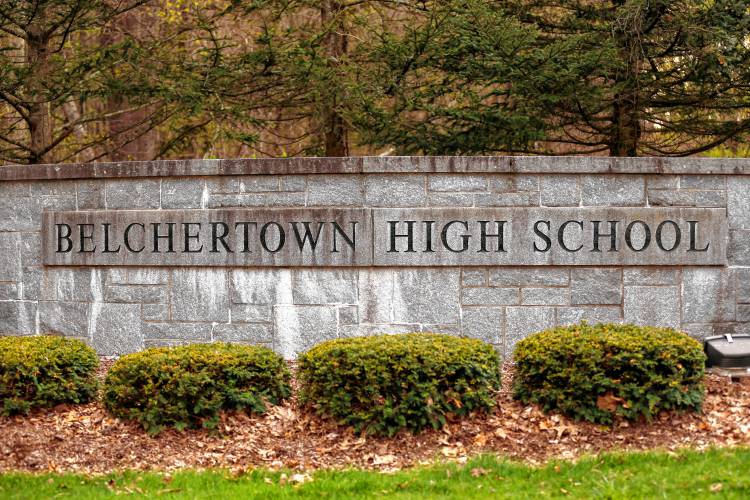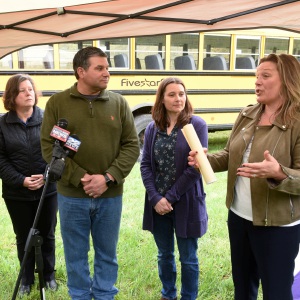School districts in region warn they are nearing edge of ‘fiscal cliff’

Belchertown High School GAZETTE FILE PHOTO
| Published: 03-14-2024 5:14 PM |
BELCHERTOWN — In what has become a steady drumbeat from school officials in many Hampshire County communities this budget season, Belchertown has become the latest to stare down a significant school budget gap that could mean the “staggering” loss of teachers and other educators.
The district needs to cut more money in fiscal 2025 — $1.2 million — than in the past five years combined, and the impact is drastic: 17.5 positions could be lost, as well as fewer elective classes and special periods, such as STEM lab or art. The proposed cuts are of 10 teaching positions and 7.5 full- and part-time support staff. In addition to the loss of personnel, the committee is also discussing raising athletic fees to cover a portion of the deficit.
“I do feel like these cuts are crippling,” School Committee Chair Heidi Gutekenst said during Tuesday’s School Committee meeting. “Every year, we do our part to carve out a little (money), but this year I feel like it’s over the top.”
Belchertown, like many communities including Northampton, South Hadley and Amherst, is grappling with the loss of pandemic-era relief money through the Elementary and Secondary School Emergency Relief, or ESSER. The federal government passed three relief packages during the pandemic that include unprecedented support for K–12 schools, but that money is drying up.
Couple that with high inflation and a trend of declining enrollments, and school committees are coming up short in trying to fund their schools.
Belchertown’s proposed $33.2 million school budget for next fiscal year is nearly 2% higher than the current fiscal year, but not nearly enough to cover the $34.4 million that school administrators say they need to provide level services, or the same services being offered this year as last.
Gutekenst said the committee knew a large cut was coming because the town in recent years has moved away from relying on free cash to maintain the schools’ operational budget. She notes that over the last five years, the district has chipped away at its budget, cutting $1.1 million worth of instruction, programs and personnel, to adapt to the fewer resources and programs.
But this year “feels like it’s a tipping point,” School Committee Vice Chair Ruby Bansal said. “To lose that number of positions, it’s just staggering.”
Article continues after...
Yesterday's Most Read Articles
In Northampton, the schools are seeking an 8% increase in next year’s budget, though the mayor is supporting a 4% increase. The smaller increase would leave a $700,000 budget gap and require at least a $2.5 million override for fiscal 2026, while an 8% increase would mean a $3.4 million deficit and create the need for two $5 million overrides in the next five years.
The Amherst Regional School Committee is currently discussing how to close a $1.69 million gap that could eliminate 14 educator positions. The district plans to use its remaining ESSER money next fiscal year.
In South Hadley, the district is facing a $1.2 million deficit in its budget next fiscal year.
Belchertown’s plight is familiar to dozens of communities statewide in what officials are calling a “fiscal cliff” that could result in a significant loss of staff and cuts to services, according to education advocacy groups that are calling on lawmakers to rethink school funding approaches.
In her fiscal 2025 budget, Gov. Maura Healey calls for a 4% increase to public education aid, called Chapter 70 funding, from $6.5 billion to $6.85 billion. This proposed $263 million increase for K-12 schools would follow a $594 million, or 9.9% increase in Chapter 70 funding in the fiscal 2024 budget. In fiscal 2021, the account stood at $5.3 billion.
Despite these injections of aid, school budgets haven’t been able to keep up with inflation, the Massachusetts Association of School Superintendents and Massachusetts Association of School Committees told lawmakers at a recent budget hearing.
In addition, they say rural schools have taken a hit as declining enrollments have left their coffers dry under the current school funding formulas, and the $1.5 billion Student Opportunity Act, meant to close education funding gaps, is mostly focused on plugging holes in urban districts.
The school groups are making their case to House Democrats, who plan in April to unveil their rewrite of Healey’s spending bill.
“We are hearing widespread reports that our districts are describing a cliff effect in the decline of budget revenue, largely due to inflation rates calculated over the past three years, which will result in significant reductions in programs and services for our students this year,” said Mary Bourque, co-executive director of the Massachusetts Association of School Superintendents.
Bourque said school costs have “increased dramatically” over the last few years due to high inflation rates, affecting everything from special education and transportation to building maintenance, curriculum costs and cost of living increases for staff.
While inflation was at 7% in fiscal 2023 and 8% in fiscal 2024, the foundation budget for schools was increased by only 4.5%, she said.
This year, Healey’s Chapter 70 allocation applied a 1.35% inflation rate to foundation budget rates. With the national inflation rate closer to 3%, the application of the lower inflation rate “leaves many districts desperately short of real cost increases, including negotiated personnel costs,” said Mildred Lefebvre, president of the Massachusetts Association of School Committees and a Holyoke School Committee member.
The superintendent and school committee groups and the two largest teachers unions in the state — the Massachusetts Teachers Association and the state branch of the American Federation of Teachers — all backed a request for lawmakers to “fix a flaw in how the Chapter 70 formula treatment of inflation” that “is causing a steep funding cliff in our school districts.”
The school-based groups suggest adding an additional 2.58% inflation in fiscal 2025 to make up for value lost in fiscal 2023, and to change the law so value lost in fiscal 2024 will be made up for in future years.
Asked by Rep. Andy Vargas how much increasing the inflation rate to their suggested amount would cost, Bourque replied, “We do admit it’s somewhere around $400 million.”
At a March 1 public hearing in Greenfield, advocates also raised concerns about how Chapter 70 counts low-income students, and directs more funding to districts that serve greater low-income populations, as the end of the pandemic emergency has shifted who qualifies for certain income-eligible programs.
Healey’s budget reinstates a stricter definition of low-income — restricting the label to families below 185% of the federal poverty level — and replacing the “economically disadvantaged” designation based on 133% of the federal poverty level used from fiscal 2017 through fiscal 2022. The Chapter 70 funding formula directs money toward districts with higher percentages of low-income students, who may need more resources and support.
The formula determines a district’s low-income enrollment based on how many students participate in state public assistance programs, including Supplemental Nutrition Assistance Program (SNAP), Transitional Aid to Families with Dependent Children (TAFDC), MassHealth, and foster care. These programs, however, have seen significant declines in enrollment over the past year as pandemic-era freezes that maintained program eligibility have expired.
With questions raised about the Chapter 70 formula as a whole, western Massachusetts advocates also argued at the March 1 budget hearing that the current funding system has led rural districts into “a financial crisis.”
“The situation that rural schools are facing is dire, and it was detailed in the 2022 rural schools report as such, that I’m quoting: ‘Rural school districts in Massachusetts struggle with a set of challenges that have left many students with less than they need and deserve. Some rural high schools have cut most of their AP courses, business programs, arts offerings, social studies, electives and oral languages,’” said Rep. Natalie Blais of Deerfield.
In these rural areas with flat population growth, small town governments must fund higher percentages of their school budgets from a stagnant tax base, according to the Special Commission on Rural School Districts’ 2022 report that Blais referenced. And with their enrollment declining as young families move out of rural areas, that has an effect on districts’ Chapter 70 funding. Between 2012 and 2020, rural district enrollment went down by 13.9%, according to the commission’s report.
The state’s biggest education funding injection of the last decade, the $1.5 million Student Opportunity Act being phased into Bay State schools over six years, was designed to direct the most funds to districts with high percentages of low-income students and English language learners. Districts in so-called gateway cities have received a significant boost.
“We know that probably 96 districts get about 80% of the dollars,” K-12 Commissioner Jeffrey Riley said last year. “We also know there’s probably more districts, probably 115 or thereabouts, that are just getting minimum aid. So in a time of inflationary pressures, this is something we need to really keep our eye on going forward.”
This year, 212 districts are projected to receive minimum aid from the state due to declining enrollment, according to Northampton Superintendent Portia Bonner. Bonner, along with MASC and MASS, requested that minimum aid be funded at $100 per student. Last year these districts got $60 per head.
“This is incredibly important for districts in the western part of the state. The ratio between low enrollment and staffing is still a considerable cost to districts. Overall, school costs are increasing faster than cities and towns can keep up with while state funding stagnates,” she said.
“Northampton strongly rallied to support the Student Opportunity Act, recognizing the important goal to increase the amount of aid to districts serving the highest needs students. However, Northampton nor our neighbor Amherst have realized any funding from SOA. I ask that you consider the financial needs of all districts.”
Sen. Jo Comerford of Northampton added that she was disappointed that the administration’s new early education and care proposal — to expand a universal preschool program into all 26 “gateway cities” by 2026 — again focused on urban centers.
“It’s not that we don’t love our gateway city colleagues,” Comerford said. “It is really that we here voted for the Student Opportunity Act that is really beginning to revolutionize, especially gateway cities ... it’s really hard to get to rural communities if we don’t start with them as well at the table.”
Comerford asked Education Secretary Patrick Tutwiler if he would be willing to look at redesigning the Chapter 70 formula and minimum aid for districts.
“We are, I think, looking at a declining spiral in districts that I represent,” she said.
The secretary replied that he was “willing to follow the Legislature on this.”
He added, when pressed by Comerford, that he would be willing to join a working group to examine school funding.
“I think that’s a beautiful offer,” Comerford replied.






 Hopeful buyers emerge for Magic Wings butterfly conservatory in South Deerfield
Hopeful buyers emerge for Magic Wings butterfly conservatory in South Deerfield Area briefs: Mount Holyoke’s Trailblazers of Color conference; Holyoke Library to host annual mini golf and games; Westfield State launches paramedic program
Area briefs: Mount Holyoke’s Trailblazers of Color conference; Holyoke Library to host annual mini golf and games; Westfield State launches paramedic program  Putting themselves on the line: Activists say nonviolent protests focus attention, inspire others, drive change
Putting themselves on the line: Activists say nonviolent protests focus attention, inspire others, drive change Legislation inspired by a Leverett family allows school bus monitoring systems
Legislation inspired by a Leverett family allows school bus monitoring systems
